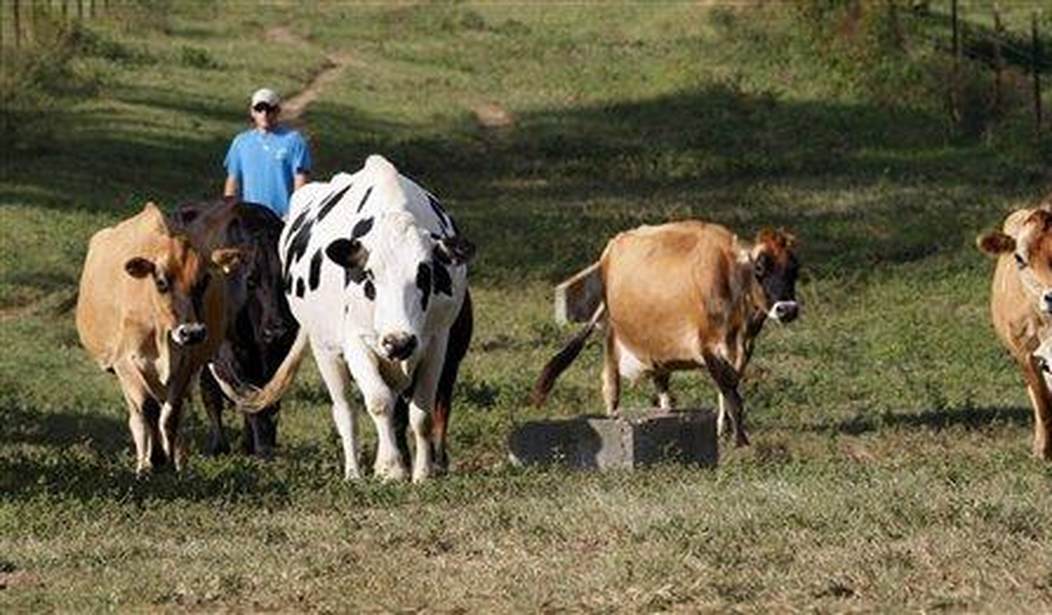The Left tends to ignore large swaths of data or technical considerations in order to get to a pre-approved “scientific” conclusion. Enron also hid its debts to paint a rosy economic picture, and we all know how that turned out.
The latest fad, pushed by the massive French yogurt company Danone, is to put diapers and masks on cows. The press reports made no mention of pacifiers. The ostensible idea is that cows, those indispensable sources of yogurt and ice cream, produce large amounts of methane both forward and aft. As anyone who has been awake for the past decade knows, methane is much, much worse than carbon dioxide in trapping reflected radiation and thus heating up our planet. While past attempts to deal with cow flatulence have included altering feed so as to produce less gas, the goal of the French is to trap the gases and prevent their release into the atmosphere. If one looks at pictures of the diapers, they by no means seem hermetic and I kind of wonder how efficient they will be in trapping CH4 molecules. While on the one hand I am glad that they have found a use for the leftover Covid masks (now selling in Israel at 10% of their peak price), I hope that the cows will still be able to recognize one another.
Let’s give the yogurt scientists the benefit of the doubt and say that their end-to-end solution really does trap all methane released and that the net effect will make life on this world better. Any serious researcher would ask, “At what cost?” The diapers are no doubt made from paper, cloth, and/or plastic products. What are the environmental considerations in the energy required for their production? At some point, they will be retired and buried in the ground. What is the environmental implication of burying millions of cow masks and diapers annually? If they are made of cloth, how much energy will be required to heat water to wash them? How much will the newest cow fashion add to the price of the final products? Will people on the lower end of the financial spectrum be pushed out of the Danone yogurt market to make the elite feel a little better about their yogurt choices?
Recommended
The need to look at all angles of any energy/environmental issue came to me when I had an opportunity to do a study for a very large American aerospace company. They wanted to know the feasibility of using algae or other biological sources for jet fuel. I worked with an engineer and together we built models for initial food source, efficiency of growth, and cost of isolation of fuel molecules. During this time, there were several high-profile flights using highly-modified palm or other oils in one engine of a commercial airliner. The one thing that they never discussed in these flights was how much the fuel actually cost. But from our study, we saw that the price of any jet fuel alternative from a biological source was going to be far more expensive than standard jet fuel, unless you could coax some bacteria or algae to thrive on coal—the cheapest source of carbon available. Once you factor in the relatively low efficiency of conversion of sunlight into carbon mass by algae or cyanobacteria, and then take into account the need for isolation of fuel molecules from the rest of the cellular material, and in the case of jet fuel their significant modification, you cannot come anywhere close to even $4 or $5 per gallon. I estimate that the “natural” fuel flown by Boeing on several different airliners cost well over $50 per gallon to grow, isolate, modify, and transport. The proof of biofuels being extremely expensive is that even with gas at $7 per gallon in California recently, nobody announced a plan to move to these gas alternatives, though they have been in development for over 20 years.
During the project, my partner and I had an opportunity to go to an algae farm on the Israeli coast. The fellow running it was a serious scientist, and he had a great set up. The Israel Electric Company gave him space, carbon dioxide and heat from their smoke stacks, water, support staff, and equipment for handling algae. While sitting in this guy’s office, he handed me a bottle with a clear liquid in it. The bottle had an official stamp: “100% Algal Diesel Fuel”. Very impressive. “So how much did it cost from start to finish?” Crickets. So I asked again. So he brought in more crickets. I would be surprised if that pretty liter of truck fuel cost less than $100 to produce. Even with so much free stuff, he could not make an economical alternative to diesel fuel.
And there are many more such stories. A very high profile lab succeeded in getting bacteria to eat sugar and produce octane. Now that’s impressive until you realize that at over $400 per ton for sugar and say 10% efficiency of conversion of sugar to fuel, you are still looking at double digit dollars per gallon for any such biofuel. And there’s the rub. Most “green” systems make no sense if you look at the whole picture, including the economics. Michael Moore figured it out in his movie Planet of the Humans about the dirty side of the green industry, and he was effectively shunned by the Left. A pioneer in the solar energy field told me point blank that when Sacramento canceled the financial support for his first big solar field, the project went into bankruptcy. Even today, the solar panels put on rooftops and windmill farms often make no business sense when all financial and energy factors are taken into consideration. California recently announced that it will no longer pay people to send their extra electricity into the grid. How many people installed expensive rooftop systems with the assumption that excess power could be sold to pay off the installation fees? They have been left high and dry.
And then there is the environmental aspect that is often ignored: what happens with those plates, turbine blades and massive batteries when they go into the ground? How much can be recycled? At what cost? What about the rest that cannot be reused? What about the slave-like African mining industry needed to make those massive EV batteries? It is the lack of honesty of those pushing the “green agenda” that causes most Americans to buy gas cars and to continue to enjoy their gas stoves and barbecues. Americans want honesty and they don’t believe the green hucksters who always seem to be right except in practice. Islands have not disappeared, there is still snow in the world, and most people seem to be getting along just as they did before, except poorer due to inflation. Al Gore thundered this week in posh Davos about a billion climate refugees. If he had said “economic” instead of climate, maybe someone would have actually believed him.
Policy decisions, whether they be governmental or familial, must be based on all of the facts available. If a hybrid car’s extra cost will never cover the additional gas expense, then a prudent person probably would stick with a gas car. If those pushing EVs, windmills, and solar panels want to get people to buy their product, then they should be honest about real costs and benefits. If that would blow their cover, then people are right to doubt them and should stay away from their products. Dutch farmers vigorously protested threats to their livelihood brought by the Davos crowd wishing to strip them of their nitrogen fertilizers. They mobilized their tractors to fight their government’s policy that only saw one side of the equation—less fertilizer, less “warming.” They completely ignored the human side of food producers and consumers who want food at reasonable prices. Sound familiar? Covid Lockdowns completely ignored human needs and business health in the name of supposedly fighting the virus.
I hope that those French cows figure out a way to rip off their diapers in protest.

























Join the conversation as a VIP Member